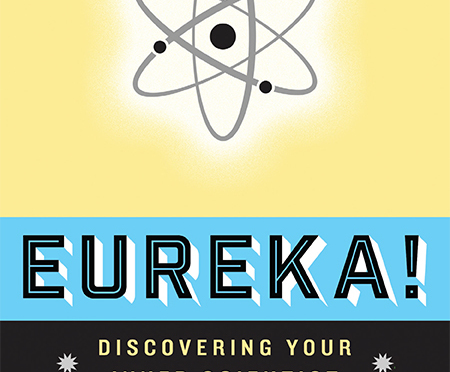Amazon, Barnes and Noble, IndieBound, Powell’s
Audio edition (March 2015): Audible
Cover Copy
Even in the twenty-first century the popular image of a scientist is a reclusive genius in a lab coat, mixing formulas or working out equations inaccessible to all but the initiated few. The idea that scientists are somehow smarter than the rest of us is a common, yet dangerous, misconception, getting us off the hook for not knowing—or caring—how the world works. How did science become so divorced from our everyday experience? Is scientific understanding so far out of reach for the non-scientists among us?
As science popularizer Chad Orzel argues in Eureka, even the people who are most forthright about hating science are doing science, often without even knowing it. Orzel shows that science isn’t something alien and inscrutable beyond the capabilities of ordinary people, it’s central to the human experience. Every human can think like a scientist, and regularly does so in the course of everyday activities. The disconnect between this reality and most people’s perception is mostly due to the common misconception that science is a body of (boring, abstract, often mathematical) facts. In truth, science is best thought of as a process: Looking at the world, Thinking about what makes it work, Testing your mental model by comparing it to reality, and Telling others about your results. The facts that we too often think of as the whole of science are merely the product of this scientific process. Eureka shows that this process is one we all regularly use, and something that everybody can do.
By revealing the connection between the everyday activities that people do—solving crossword puzzles, playing sports, or even watching mystery shows on television—and the processes used to make great scientific discoveries, Orzel shows that if we recognize the process of doing science as something familiar, we will be better able to appreciate scientific discoveries, and use scientific facts and thinking to help address the problems that affect us all.

People Saying Nice Things About It:
“This fun, diverse, and accessible look at how science works will convert even the biggest science phobe.” —Publishers Weekly (starred review)
“Similar to Richard Rhodes or Dava Sobel, Orzel makes complicated scientific narratives accessible to lay readers.” —Library Journal
“In writing that is welcoming but not overly bouncy, persuasive in a careful way but also enticing, Orzel reveals the ‘process of looking at the world, figuring out how things work, testing that knowledge, and sharing it with others.’” —Kirkus Reviews
“I know, I know, you think you’re just not smart enough to be a scientist. Chad Orzel might convince you otherwise with Eureka. Drawing on basketball, stamp collecting, Angry Birds, Iron Chef, and Antiques Roadshow among his many colorful examples, he ably demonstrates that science is not a rarefied alien endeavor performed solely by those with genius IQs. It’s a process, and a way of thinking about the world available to all. Surprise! You’re probably committing acts of science every day.”—Jennifer Ouellette, author of The Calculus Diaries and Me, Myself and Why
“Chad Orzel is absolutely right: everyone has a scientist inside them, eager to burst out and look at the world in a new way. This book provides great examples that will inspire you to let your inner scientist free.”—Sean Carroll, theoretical physicist at Caltech and author of The Particle at the End of the Universe
“Many people are curious about the natural world, but few consider themselves scientists. Using an engaging array of examples of scientific discovery—some recent, others drawn from history—Chad Orzel takes readers on a wonderful tour of how scientists think.”—David Kaiser, Germeshausen Professor of the History of Science, MIT and author of How the Hippies Saved Physics: Science, Counterculture, and the Quantum Revival
“Chad Orzel’s previous two books were just fine and dandy. However, this one is awesome. If anyone wants an insight into nature and the process of science, this is the book to get. Chad uses his witty writing style along with historical stories to show that science is part of our human nature.
Do you have a non-scientist friend? They will love this book. Or maybe your friend is a scientist—yup, it’s for scientists too.”—Rhett Allain, Professor of Physics at Southeastern Louisiana University and author of WIRED Magazine’s Dot Physics







